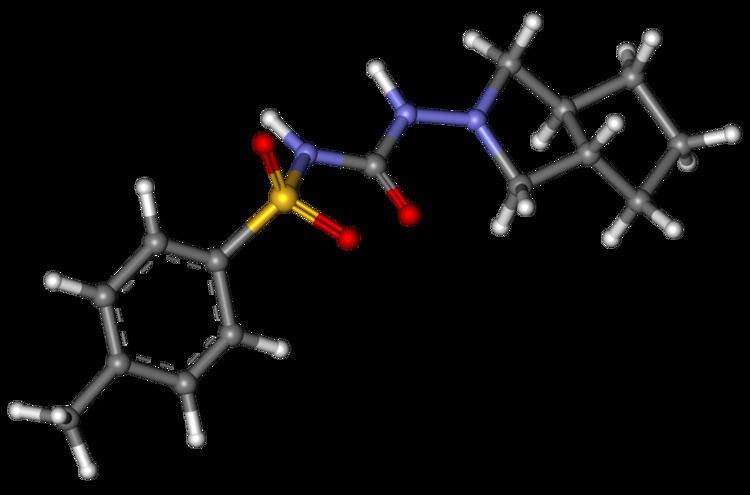Trade names Diamicron, others ATC code A10BB09 (WHO) CAS ID 21187-98-4 | Pregnancycategory AU: C Biological half-life 10.4 hours Molar mass 323.412 g/mol | |
 | ||
AHFS/Drugs.com Micromedex Detailed Consumer Information Legal status AU: S4 (Prescription only) | ||
Gliclazide
Gliclazide, sold under the brand name Diamicron among others, is an anti-diabetic medication used to treat diabetes mellitus type 2. It is used when dietary changes, exercise, and weight loss are not enough. It is taken by mouth.
Contents
- Gliclazide
- Overview of sulfonylurea medications
- Medical uses
- Contraindications
- Adverse effects
- Interactions
- Overdose
- Mechanism of action
- Properties
- Metabolism
- References
Side effect may include low blood sugar, vomiting, abdominal pain, rash, and liver problems. Use by those with significant kidney problems, liver problems, or who are pregnancy is not recommended. Gliclazide is in the sulfonylurea family of medications. It works mostly by increasing the release of insulin.
Gliclazide was patented in 1966 and approved for medical use in 1972. It is on the World Health Organization's List of Essential Medicines, the most effective and safe medicines needed in a health system. The wholesale cost in the developing world is about 2.46 to 3.92 USD per month. In the United Kingdom a month of medication costs the NHS about 2.12 pounds. It is not available for sale in the United States.
Overview of sulfonylurea medications
Medical uses
Gliclazide is used for control of hyperglycemia in gliclazide-responsive diabetes mellitus of stable, mild, non-ketosis prone, type 2 diabetes. It is used when diabetes cannot be controlled by proper dietary management and exercise or when insulin therapy is not appropriate. National Kidney Foundation (2012 Update) claims that Gliclazide does not require dosage uptitration even in end stage kidney disease.
Contraindications
Adverse effects
Interactions
Hyperglycemic action may be caused by danazol, chlorpromazine, glucocorticoids, progestogens, or β-2 agonists. Its hypoglycemic action may be potentiated by phenylbutazone, alcohol, fluconazole, β-blockers, and possibly ACE inhibitors. It has been found that rifampin increases gliclazide metabolism in humans in vivo.
Overdose
Gliclazide overdose may cause severe hypoglycemia, requiring urgent administration of glucose by IV and monitoring.
Mechanism of action
Gliclazide selectively binds to sulfonylurea receptors (SUR-1) on the surface of the pancreatic beta-cells. It was shown to provide cardiovascular protection as it does not bind to sulfonylurea receptors (SUR-2A) in the heart. This binding effectively closes the K+ ion channels. This decreases the efflux of potassium from the cell which leads to the depolarization of the cell. This causes voltage dependent Ca++ ion channels to open increasing the Ca++ influx. The calcium can then bind to and activate calmodulin which in turn leads to exocytosis of insulin vesicles leading to insulin release. The mouse model of MODY diabetes suggested that the reduced gliclazide clearance stands behind their therapeutic success in human MODY patients, but Urbanova et al. found that human MODY patients respond differently and that there was no consistent decrease in gliclazide clearance in randomly selected HNF1A-MODY and HNF4A-MODY patients.
Its classification has been ambiguous, as literature uses it as both a first-generation and second-generation sulfonylurea.
Properties
Water solubility = 0.027 mg/L
Metabolism
Gliclazide undergoes extensive metabolism to several inactive metabolites in human beings, mainly methylhydroxygliclazide and carboxygliclazide. CYP2C9 is involved in the formation of hydroxygliclazide in human liver microsomes and in a panel of recombinant human P450s in vitro. But the pharmacokinetics of gliclazide MR are affected mainly by CYP2C19 genetic polymorphism instead of CYP2C9 genetic polymorphism.
